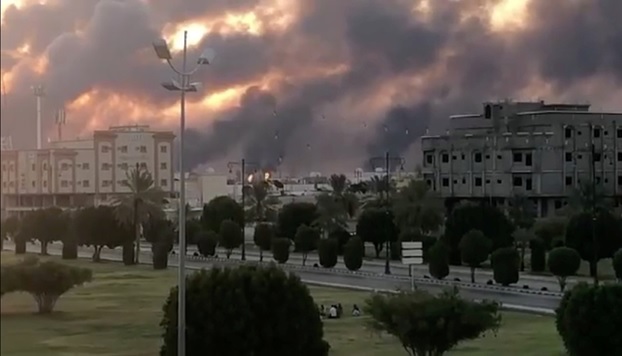Last Saturday, a missile and drone strike on Saudi Arabia took out about half the Kingdom’s daily production capacity — 5.7 million barrels per day (bpd), or about 5% of the global total. About a third of that lost capacity was restored rapidly, within 24 hours; on Tuesday, Reuters reported that normal production would be restored in two or three weeks. Although rebels in Yemen claimed responsibility for the attack, U.S. and global intelligence quickly determined that Iran was the more likely source — particularly since the attacks showed a sophistication far beyond what Yemen’s Houthi insurgents had ever previously demonstrated.
Saudi Social Media Showed Drone and Missile Attack on Oil Facilities

The price reaction for oil was sharp on Monday. Much of that move was quickly retraced on Tuesday as the limited nature of the damage and the likelihood of a rapid recovery became apparent.
A straightforward “mechanical” analysis of supply disruptions suggests that a one million bpd disruption that lasts for a year would cause the price of oil to rise by $15 per barrel. However, the current disruption will fall far short of that damage, with a total market impact of 40 to 70 million lost barrels — a small amount compared to global stockpiles, and well within the estimated 188 million barrels of crude stockpiled in the Kingdom itself. (Globally, an estimated 1.8 billion barrels are stockpiled, including 600 million in the United States.)
The objective damage of the attacks was slight. Their real significance is, of course, geopolitical.
The rise of fracking in the United States has dulled the sharp edge of American dependence on a region of the world that’s fraught with enduring conflicts. But much of the rest of the world is not fortunate enough to be blessed with the U.S.’ combination of geology, technology, robust capital markets, and the rule of law (the things that have unlocked vast new U.S. oil reserves). For the much of the rest of the world — including India and China — Saudi Arabia remains the “central bank of oil,” the swing producer of last resort with spare capacity that can make up for disruptions elsewhere.
The attacks may not have been highly damaging or disrupting, but they have highlighted risks that oil markets have evidently not fully priced in — not unknown risks, just currently unpriced ones.
- First, in spite of the rise of U.S. oil production, Saudi is still the world’s key swing producer — and Saudi production has significant bottlenecks, including the Abqaiq processing facility that was struck in the attack.
- Second, a war with Iran has been feared for so many decades that most observers have become complacent about the risk. Still, Iran maintains deep ties with regional asymmetrical militias that are capable of either conducting proxy attacks on Iran’s behalf, or of distracting attention from activity that covertly originated from Iran itself. (Intelligence seems to suggest that the latter is what happened on Saturday.) In short, while a regional war involving Iran remains unlikely, Iran can still have a significant and destabilizing regional influence.
- Third, technology (drones, cyber warfare, etc.) means that destructive asymmetrical attacks can more easily be launched by non-state actors (though often with covert state backing). Those attacks will increase in sophistication and efficacy as the technological means become cheaper and more accessible.
These risks may now start to be priced into oil more consistently. We foresee a somewhat durable risk premium of $5 or maybe $10 being added to a barrel of oil over the coming months — though with all the other drivers in place (particularly, the strength or weakness of overall global economic growth), that risk premium will not be decisive on its own to determine the path of the price of oil.
Investment implications: The recent attack on Saudi oil production is not a disaster from a geopolitical perspective, and a small positive from an economic and market perspective — particularly from a U.S. point of view. The oil price spike after the attack has afforded some small and mid-sized exploration and production companies the opportunity to hedge future production at higher prices, easing cash flow concerns and better ensuring cash return to shareholders. As a higher risk premium is priced into oil over coming months, that will lead to a modest bump in inflation — more in developing countries that are large energy producers (particularly India and China). That modest inflation effect will, in turn, be a further small positive for gold.







